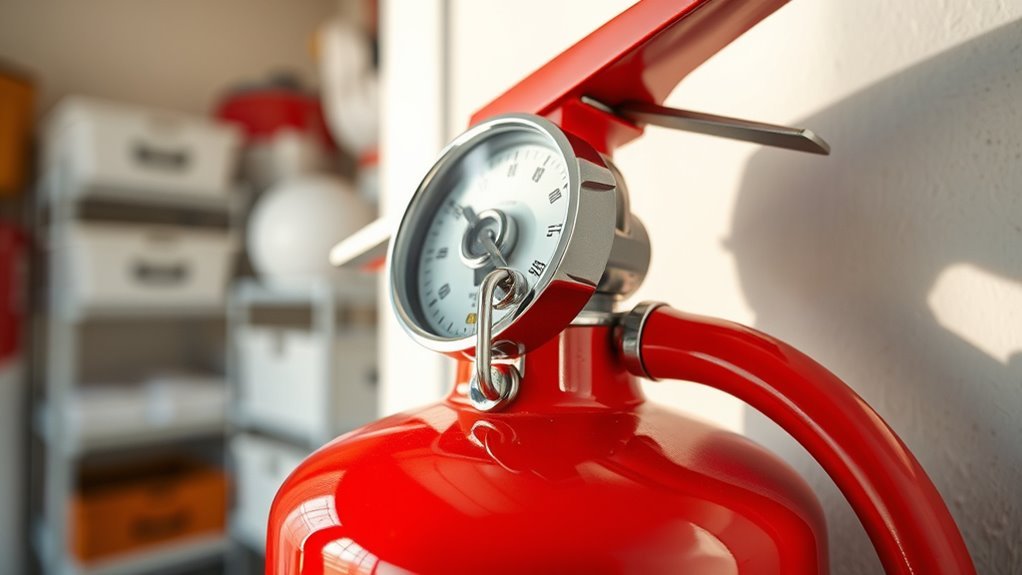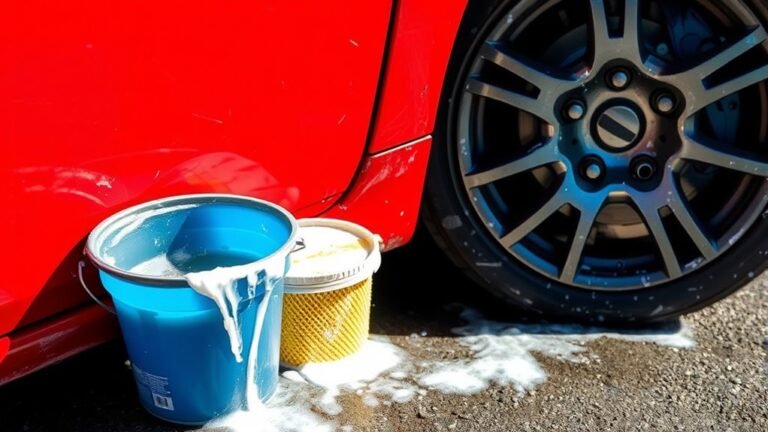How to Clean and Store Fire Extinguishers Properly
You should inspect your fire extinguisher monthly for damage and pressure, ensuring the gauge stays in the green zone. Use mild detergent and water with a soft cloth to clean its exterior, avoiding water immersion. Store it in an accessible, visible spot at eye level near exits, free from obstructions. Regular maintenance and annual professional inspections keep it ready for emergencies. If you want to know more about proper cleaning steps and smart storage choices, keep exploring.
Inspecting Your Fire Extinguisher Regularly

Before an emergency arises, you should inspect your fire extinguisher regularly to confirm it’s in proper working order. Different fire extinguisher types require specific attention, so knowing what kind you have is key to proper care. Your inspection frequency depends on the type and manufacturer’s guidelines, but a monthly check is generally recommended. During your inspection, verify the pressure gauge is in the green zone, the nozzle isn’t blocked, and the safety pin is intact. Also, check for signs of rust, dents, or corrosion. Staying vigilant means you’re prepared to act freely and confidently in emergencies without hesitation. Regular inspections empower you to maintain safety while preserving your independence and peace of mind.
Gathering the Necessary Cleaning Supplies
Before you start cleaning, make sure you have the right tools on hand, like soft cloths and brushes. You’ll also need gloves and eye protection to handle the extinguisher safely. Finally, choose cleaning agents that won’t damage the extinguisher’s surface or internal components.
Essential Cleaning Tools
Cleaning a fire extinguisher properly means having the right tools on hand. You’ll want soft cloths or microfiber towels to avoid scratching the surface while applying your cleaning techniques. A gentle detergent mixed with water works best for removing dirt without damaging the extinguisher’s finish. Don’t forget a small brush to reach crevices and valve areas where dust might gather. Gloves can protect your hands during cleaning, but we’ll cover protective gear more thoroughly later. Once clean, using proper storage solutions like wall brackets or cabinets will keep your extinguisher accessible and in good shape. With these essential cleaning tools ready, you maintain your extinguisher’s reliability and guarantee it’s always ready when freedom calls for safety.
Safe Handling Equipment
Having the right tools is only part of the process; handling your fire extinguisher safely while cleaning is just as important. Before you begin, make certain you have the proper protective gear like gloves and safety goggles to shield yourself. Safe handling isn’t just about the gear—it requires equipment training so you understand how to move and clean the extinguisher without causing damage or risking injury. If you’re new to this, consider a brief training session or tutorial to build your confidence. Remember, your freedom to maintain your safety equipment depends on respecting the right procedures. By combining the right safety equipment with trained handling techniques, you guarantee your fire extinguisher stays reliable and ready when you need it most.
Suitable Cleaning Agents
While selecting cleaning agents for your fire extinguisher, you’ll want to choose products that effectively remove dirt and grime without damaging its surface or internal components. Opt for mild, non-abrasive cleaning agents like diluted dish soap or gentle all-purpose cleaners. These suitable products guarantee the extinguisher remains intact and fully functional after cleaning. Avoid harsh chemicals, solvents, or abrasive scrubs that could compromise safety seals or corrode metal parts. Make certain any cleaning agent you pick is safe for both plastic and metal surfaces. By using the right cleaning agents, you maintain your extinguisher’s reliability and extend its lifespan, giving you peace of mind and freedom from worry. Gather these suitable products before you start, so the process goes smoothly and safely.
Steps to Clean the Exterior of a Fire Extinguisher
Before you start, make sure the fire extinguisher is fully charged and disconnected from any mounting brackets. For effective fire extinguisher maintenance, begin by wiping the exterior with a dry cloth to remove loose dust and dirt. Next, dampen a soft cloth with a mild cleaning agent approved for exterior cleaning. Gently wipe the surface, avoiding harsh chemicals that can damage the finish or labels. Pay close attention to the nozzle and handle, ensuring all areas are clean but never immerse the extinguisher in water. After cleaning, dry the extinguisher thoroughly with a clean cloth to prevent rust. Following these steps regularly keeps your extinguisher in top shape while preserving freedom from unexpected failures when you need it most.
Checking the Pressure Gauge and Safety Pin

Now that the exterior is clean, you’ll want to check the pressure gauge to guarantee it’s in the green zone. Don’t forget to verify the safety pin is securely in place to prevent accidental discharge. These steps are essential for keeping your fire extinguisher ready to use.
Inspecting Pressure Gauge
One essential step in maintaining your fire extinguisher is inspecting the pressure gauge and safety pin to guarantee they’re in proper working order. When focusing on the pressure gauge, you’ll notice there are different pressure gauge types, including analog and digital. Each displays the pressure level inside the extinguisher, which is vital to ensuring it will work when needed. It’s important to understand the gauge calibration importance—an uncalibrated gauge can give false readings, leaving you unprotected. Regularly check that the needle is in the green zone, indicating ideal pressure. If it’s in red or off-scale, your extinguisher may not function correctly and needs servicing. By staying vigilant with these inspections, you maintain your freedom to act confidently during emergencies.
Securing Safety Pin
After confirming the pressure gauge reads within the green zone, you should check the safety pin to confirm it’s secure. The safety pin prevents accidental discharge and guarantees your extinguisher is ready when freedom calls. Different safety pin types exist, such as metal, plastic, or tamper-evident seals, each requiring specific securing methods.
To secure the safety pin properly, keep these points in mind:
- Confirm the pin fits snugly through the handle and trigger, preventing movement.
- Use tamper seals or plastic ties to indicate if the pin has been disturbed.
- Regularly inspect the pin for wear or corrosion that may affect its hold.
Identifying Proper Storage Locations
Although choosing the right spot for your fire extinguisher might seem straightforward, it’s crucial to pick locations that are both easily accessible and visible during emergencies. You want to verify your extinguisher is stored where anyone can grab it quickly without obstruction. When selecting fire extinguisher locations, keep in mind the storage regulations that apply to your area or building type. These rules often specify mounting height and distance from potential fire hazards. By following these guidelines, you protect your freedom to act decisively when needed while staying compliant. Avoid hidden corners or cluttered spaces; instead, opt for open, well-lit areas near exits or high-risk zones. Proper placement not only meets legal standards but also empowers you and others to respond effectively when every second counts.
How to Store Fire Extinguishers for Easy Access

Accessibility is key when storing fire extinguishers to guarantee you can reach them quickly during an emergency. Proper fire extinguisher placement guarantees you’re never fumbling or blocked by obstacles when seconds count. Think about your home’s layout and identify clear access points that everyone knows.
To keep your extinguishers ready and reachable, remember to:
- Mount them at eye level near common exit routes or high-risk areas.
- Avoid placing them behind doors, furniture, or in cramped corners.
- Clearly label their locations so visitors or guests can find them instantly.
Scheduling Routine Maintenance and Professional Inspections
Since fire extinguishers play an essential role in safety, you need to schedule regular maintenance and professional inspections to confirm they’re always in working order. Setting a clear maintenance schedule helps you stay on top of checks without hassle. Typically, you should inspect your fire extinguisher monthly for visible damage and verify it’s fully charged. However, professional inspections usually happen once a year, following the recommended inspection frequency by safety standards. By keeping up with these routines, you maintain your freedom from worry, knowing your extinguisher will perform when needed. Don’t wait for an emergency to realize maintenance slipped—plan ahead, stick to your schedule, and let professionals handle detailed inspections to keep your safety tools reliable and ready.
Frequently Asked Questions
Can I Use Water to Clean the Inside of a Fire Extinguisher?
Did you know over 40% of fire extinguishers fail due to improper maintenance? When it comes to cleaning the inside of a fire extinguisher, you shouldn’t use water. Water can cause serious water damage and compromise the extinguisher’s effectiveness. Instead, stick to recommended cleaning methods like using a dry cloth or compressed air for the exterior. Protect your freedom by ensuring your extinguisher stays reliable and ready when you need it most.
How Long Do Fire Extinguishers Typically Last Before Replacement?
A fire extinguisher lifespan usually ranges from 5 to 15 years, depending on the type and manufacturer. You’ll want to keep an eye out for replacement indicators like corrosion, physical damage, or if it fails a professional inspection. Staying on top of these signs guarantees you’re always ready to protect your freedom and safety. Don’t hesitate to replace your extinguisher when it’s showing wear or nearing that lifespan limit.
Are There Specific Fire Extinguisher Types for Different Fire Classes?
Absolutely, you’ll find different fire extinguisher types designed for specific fire class categories. For instance, Class A extinguishers tackle ordinary combustibles, while Class B handles flammable liquids. Class C is meant for electrical fires, and Class D targets combustible metals. Knowing these categories lets you choose the right extinguisher, giving you the freedom to protect yourself effectively without second-guessing during emergencies. Always match your extinguisher to the fire class you might face.
Can Expired Fire Extinguishers Still Be Used in an Emergency?
Think of an expired extinguisher as a rusty shield in your battle for safety—it might fail when you need it most. Using expired extinguishers risks leaving you vulnerable during an emergency, compromising your emergency preparedness. You want freedom to act confidently, so regularly check your extinguisher’s date and replace it when expired. That way, you’re truly ready to protect yourself and your space without hesitation or fear.
How Do I Dispose of a Fire Extinguisher Safely When It’s No Longer Usable?
When your fire extinguisher’s no longer usable, don’t just toss it out. You’ve got options like fire extinguisher recycling programs that help keep harmful materials from cluttering landfills. If that’s not available, take it to a hazardous waste disposal site to make sure it’s handled safely. This way, you’re protecting the environment while freeing yourself from worry about improper disposal. It’s all about making responsible choices that give you peace of mind.






